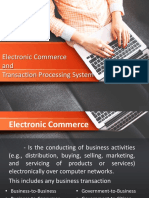0% found this document useful (0 votes)
30 views8 pagesChapter 5
This document provides an overview of electronic commerce and enterprise systems. It discusses e-commerce models and applications, the technology infrastructure needed to support e-commerce, transaction processing systems, and how enterprise systems can help manage key business functions like inventory, orders, supply chain, and customers for e-commerce operations.
Uploaded by
abdum1928Copyright
© © All Rights Reserved
We take content rights seriously. If you suspect this is your content, claim it here.
Available Formats
Download as PPTX, PDF, TXT or read online on Scribd
0% found this document useful (0 votes)
30 views8 pagesChapter 5
This document provides an overview of electronic commerce and enterprise systems. It discusses e-commerce models and applications, the technology infrastructure needed to support e-commerce, transaction processing systems, and how enterprise systems can help manage key business functions like inventory, orders, supply chain, and customers for e-commerce operations.
Uploaded by
abdum1928Copyright
© © All Rights Reserved
We take content rights seriously. If you suspect this is your content, claim it here.
Available Formats
Download as PPTX, PDF, TXT or read online on Scribd
/ 8






















































